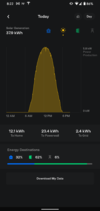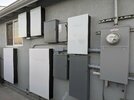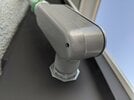So my install by Tesla finally completed yesterday. I thought I would post an overview since everything seems to have worked out pretty well and we tend to get more posts here about people with problems as you would expect.
My system is 8.16 kW of solar with 2 Powerwall 2's (not +'s). Here is a rough schedule on how the process went.
March - Ordered system
April - On site assessment
April - June - Design churn
July - Permits Issued
August - First Install Attempt - Aborted due to roof condition
September - Reroof
October - Successful Install
I am glad that they stopped the first install, but I wish it would have been caught earlier during the on site assessment. We have only been living here for a couple of years so I didn't know the age of the roof. It looked okay to me maybe slightly marginal, but I am certainly not a roof expert. For the reroof I had to remove my solar thermal pool panels which I did myself. In doing so I really got to see how bad the condition was. As I was removing the anchors the asphalt shingles would easily tear away.
Here is the as-installed layout:

There was one change on the day of install. I originally had six panels in a landscape orientation on the west facing 2nd floor roof. They found that the last two panels would not fit so they changed the layout to portrait orientation to fit five panels and moved the last panel to the first story west facing roof. The lead roofer let me know and made sure I was okay with it. He also pointed out the locations where they would bring the conduit up through the roof and made sure I was fine with the locations.
As far as the electrical design, I would have expected them to wire the panels that are on the same elevation and azimuth into the same string but they kept each set of panels on any one roof plane on their own separate string. This means that I have a total of 5 strings so the design included both a 7.6 kW inverter and a 3.6 kW inverter giving an AC-DC ratio <1. I would have thought they would have wanted to save themselves the cost of the extra inverter but maybe there is something else that goes in to that decision.
The install went smoothly other than the slight change in panel layout. The started just before 8 am and didn't finish until about 6pm. Unfortunately being after sunset they were not able to test out the solar fully. They left the solar on and mentioned I was in self consumption mode and would not export to the grid. I thought that was only possible with the Powerwall 2+, so maybe he was mistaken. I didn't say anything since I didn't want him to turn it off. I will see later today or tomorrow when my Powerwalls fill up. The other thing that I didn't get to test is whether my AC will turn on off grid. I will have to test that myself this weekend.
I'm just about at solar noon on my first day of production. So far it's peaked out at 5.8 kW and generated 18 kWh so would expect by the end of the day I will be over 30 kWh which is around my average daily usage when we are not using AC. These numbers seem pretty respectful for mid October.
Now it is onto waiting for inspection and PTO which I am not expecting anytime soon. They will have to refill the permits prior to inspection given the layout change so I would expect it is going to be another month for that to happen and then PTO is anyone's guess.
My system is 8.16 kW of solar with 2 Powerwall 2's (not +'s). Here is a rough schedule on how the process went.
March - Ordered system
April - On site assessment
April - June - Design churn
July - Permits Issued
August - First Install Attempt - Aborted due to roof condition
September - Reroof
October - Successful Install
I am glad that they stopped the first install, but I wish it would have been caught earlier during the on site assessment. We have only been living here for a couple of years so I didn't know the age of the roof. It looked okay to me maybe slightly marginal, but I am certainly not a roof expert. For the reroof I had to remove my solar thermal pool panels which I did myself. In doing so I really got to see how bad the condition was. As I was removing the anchors the asphalt shingles would easily tear away.
Here is the as-installed layout:
There was one change on the day of install. I originally had six panels in a landscape orientation on the west facing 2nd floor roof. They found that the last two panels would not fit so they changed the layout to portrait orientation to fit five panels and moved the last panel to the first story west facing roof. The lead roofer let me know and made sure I was okay with it. He also pointed out the locations where they would bring the conduit up through the roof and made sure I was fine with the locations.
As far as the electrical design, I would have expected them to wire the panels that are on the same elevation and azimuth into the same string but they kept each set of panels on any one roof plane on their own separate string. This means that I have a total of 5 strings so the design included both a 7.6 kW inverter and a 3.6 kW inverter giving an AC-DC ratio <1. I would have thought they would have wanted to save themselves the cost of the extra inverter but maybe there is something else that goes in to that decision.
The install went smoothly other than the slight change in panel layout. The started just before 8 am and didn't finish until about 6pm. Unfortunately being after sunset they were not able to test out the solar fully. They left the solar on and mentioned I was in self consumption mode and would not export to the grid. I thought that was only possible with the Powerwall 2+, so maybe he was mistaken. I didn't say anything since I didn't want him to turn it off. I will see later today or tomorrow when my Powerwalls fill up. The other thing that I didn't get to test is whether my AC will turn on off grid. I will have to test that myself this weekend.
I'm just about at solar noon on my first day of production. So far it's peaked out at 5.8 kW and generated 18 kWh so would expect by the end of the day I will be over 30 kWh which is around my average daily usage when we are not using AC. These numbers seem pretty respectful for mid October.
Now it is onto waiting for inspection and PTO which I am not expecting anytime soon. They will have to refill the permits prior to inspection given the layout change so I would expect it is going to be another month for that to happen and then PTO is anyone's guess.





